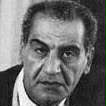
1895 - 1984
Gourgen Mkrtich Yanikian
Summary
Name:
Years Active:
1973Birth:
December 24, 1895Status:
DeceasedClass:
MurdererVictims:
2Method:
ShootingDeath:
February 27, 1984Nationality:
USA
1895 - 1984
Gourgen Mkrtich Yanikian
Summary: Murderer
Name:
Gourgen Mkrtich YanikianStatus:
DeceasedVictims:
2Method:
ShootingNationality:
USABirth:
December 24, 1895Death:
February 27, 1984Years Active:
1973bio
Gourgen Mkrtich Yanikian was born on December 24, 1895, in Erzurum, which was part of the Ottoman Empire. His early life was affected by the violence against Armenians during that time. His family managed to escape to a safer place when the anti-Armenian massacres started. They returned to Erzurum eight years later to collect belongings they had hidden. Unfortunately, during this visit, his elder brother Hagop was killed by two Turkish men.
While Yanikian was studying to become an engineer at the University of Moscow, World War I began. He learned about the persecution of Armenians in the Ottoman Empire. In spring 1915, he traveled to the Caucasus and joined a volunteer regiment of the Russian Army. His goal was to find out what happened to his family members, who he had not heard from since the war started. Yanikian served in an engineering unit, mapping the terrain for the army. As he advanced with the Russian troops, he witnessed the terrible destruction faced by Armenians.
When he arrived back in Erzurum, he found his father's business was destroyed, and he recognized the bodies of some relatives. He later stated that during the genocide, he lost twenty-six members of his extended family.
After the war, Yanikian completed his education and moved to Iran in 1930 with his wife, Suzanna. They made a life in Tehran, where Suzanna opened a gynecological clinic, and Yanikian started a civil engineering company called RAHSAZ. His work included overseeing the construction of a railroad in Iran during World War II. The projects helped him become wealthy.
In 1946, Yanikian and his wife moved to the United States, first living in New York City before moving to Beverly Hills. He opened a theater, which was not successful. Later, they moved to Fresno, California, where there was a large Armenian community. Yanikian claimed to have been a radio host there. Eventually, they relocated to Santa Barbara, California.
While in Santa Barbara, Yanikian started developing properties, but these ventures were not successful, leading to financial troubles. Over the years, he wrote several novels. By the late 1960s, Yanikian's financial situation had worsened, and he was living on welfare. His wife, suffering from dementia, was in a care home. Despite visiting her often and bringing treats, the burden of her medical care further contributed to his struggles.
In late 1972, Yanikian received a letter from the U.S. State Department telling him not to contact them again. He had been trying to collect money he believed he was owed from Iran for construction projects.
murder story
On January 27, 1973, Gourgen Yanikian invited two Turkish diplomats, Consul General Mehmet Baydar and Vice-Consul Bahadır Demir, to a lunch at the Biltmore Hotel in Santa Barbara, California. Yanikian told them he wanted to give Turkey a bank note and a stolen painting. He had contacted Baydar three months before, insisting on this meeting. Since Baydar did not drive, Demir accompanied him.
During their lunch, Yanikian revealed that he was Armenian, not Iranian as he had previously claimed. Baydar expressed anger, and there was a confrontation. In this moment, Yanikian pulled out a Luger pistol. He fired nine shots, hitting both men without killing them. Then he took out another gun and shot each of them in the head.
After the shooting, Yanikian called the hotel front desk and stated he had killed two men. Prior to this meeting, he had sent a letter urging Armenians to attack Turkish diplomats. The Turkish Embassy responded, demanding action from the United States to protect its nationals.
Yanikian was arrested and charged with two counts of first-degree murder. During the trial, he claimed he acted against two representations of evil. He admitted planning the killings for many months. The jury did not accept his claim of diminished mental capacity and found him guilty. On July 2, 1973, he was sentenced to life in prison.
Even though he was found guilty, Yanikian believed he was fighting for justice related to the Armenian genocide. He was paroled on January 31, 1984, due to poor health, and he died a month later from a heart attack. In 2019, his remains were moved to Armenia and buried in the Yerablur Pantheon in Yerevan.